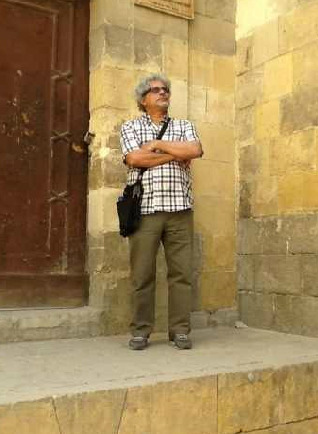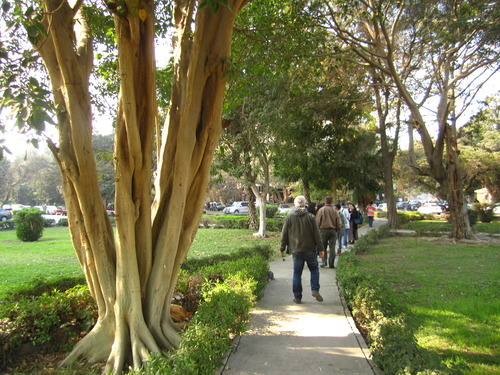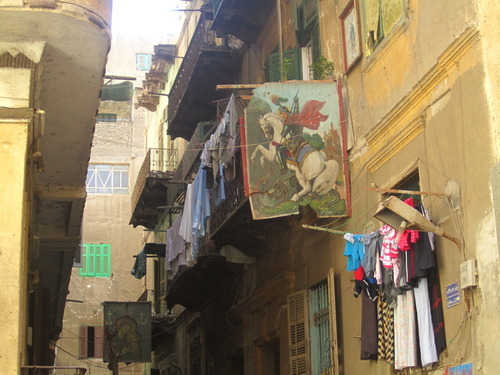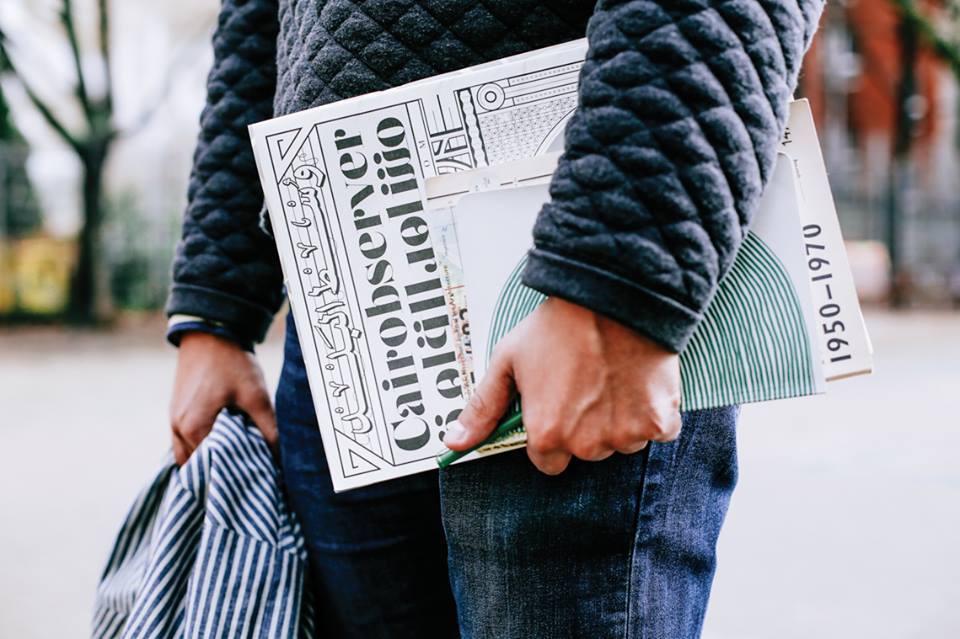Walking the city: an interview with Nabil Shawkat on the pleasures of exploring Cairo on foot

Walking is a fundamental part of experiencing the city. Until 1900, Cairo was a compact dense walkable city, by 1950 the city stretched out to the south, north-east and cross the Nile but it was also serviced with an extensive tram network and it was still a very walkable city. Besides simply being a means of getting from one point to another, walking can be a social experience, it can be exploratory or even contemplative.
With the increase in personal cars, the decrease of quality in public transport, the expansion of the city into the desert, the exodus and continuous self-segregation of the upper classes, with the lack of investment by the moneyed class into urban lifestyles and old districts, deterioration of civic pride and finally the policies of neglect by the state, walking has lost its appeal to many of the city’s residents. Walking for pleasure, for exploration or walking as a social experience in the heart of the urban core seems like a novel idea in today’s Cairo. The poor conditions of the streets and sidewalks don’t help either.
But for those who are willing to venture out for the pleasures of (re)discovering the city on foot, it can be a very rewarding experience. Naturally, the best time to walk around Cairo for fun is early Friday mornings. Everyone can start exploring the city on foot starting next Friday, it is an important step to see through the dust and the massive anti-Cairo sentiment so many of the city’s residents have come to accept and to find the interesting, hidden, historic, and pleasurable potentials of the city. No need to go far, you can start by exploring your own district regardless of what or where it is, it will be interesting.
Linguist, baker, freelance writer and Cairophile Nabil Shawkat has been leading walks almost weekly with a group of Cairo residents and the occasional visitor. Cairobserver asked Nabil some questions about walking in Cairo.
When did you start your Friday walks as a group activity, and how did it all begin?
We never planned to form this group. It all started with Jim Antinou’s wonderfully illustrated book A Walk Through the Islamic City. I loved this book and wanted to do the walk, so I told friends at a party that I need fellow walkers. We did a walk, I was satisfied, and didn’t plan more walks. But the next week they called and demanded another walk. Then called again, and so it all started. This was back in 2008 and we have been doing the walks on and off since then. The group has changed since then, some people left for other countries, new people joined. In all, about 8 to 10 people show up for the walk. The perfect number is perhaps 5 or 6. When we are more than 10 people we have to be more careful because we become too visible to ignore, and the narrow back streets (which are our main interest) become harder to negotiate. Also when the number gets too big, we tend to waste more time looking for each other and waiting for the stragglers.
Describe a typical walking day (where you begin, how you choose a destination or route, what you look for along the way…)
We don’t have an itinerary planned ahead most of the time. We just leave the coffee shop (near Tahrir Square) and in the following minute or so take a quick vote and go with the majority.
Having said that, the areas worthy of our interest are really well defined. We cover everything that the tourists don’t usually cover. Residential buildings from 1850 to 1950 take most of our attention, as well as the usual mix of mosques. We are also in love with saint shrines, especially the little known ones in the back streets.
Some of us have an interest in architecture; Michael in particular has an amazing eye for old lanterns from the early 20th century or earlier. I love the 1967 brick walls that were built supposedly for urban warfare or bomb protection in front of buildings, and we always photograph these when we find them. Dana who is a professional photographer has an interest in cats and several of us tend to take photos of shop displays when they are unusual. Political posters and elections posters seem to attract our attention as well.

What does walking reveal about the city that other means cannot offer.
I am interested in architecture and therefore can lose myself in the architecture and forget the people in the streets. But I discovered that this cold attitude is untenable, simply because people want to interact. The areas we visit are often outside the tourists’ beaten track and the inhabitants invariably say jokes about it, on the assumption that we don’t speak Arabic, or offer to show us interesting buildings, or offer us tea in their homes. The natural reaction of people is to claim ownership of their turf by interacting with these foreign elements (anyone who has no business such as buying or selling or visiting acquaintances). The interest takes two forms: hospitable and aggressive. I would say that bashful interest is the usual reaction, when people comment to each other and just eye us from a distance. Then there is engagement when they come and talk to us or make a suggestion. It gets choppy when the interest, legitimate as it is, takes an aggressive form. Then you can get a self-appointed vigilante denouncing the walkers as visitors interested only in shaming Egypt (because they take pictures of what seems to be decrepit houses or even garbage – for some reason a lot of interesting doors and walls have heaps of garbage in front of them.
This is the soft accusation (tarnishing Egypt’s image), and it is very common, perhaps once every two walks. The harder accusation is that of espionage, but this is thankfully less often (perhaps two or three times a year).
I am often stunned by the amateur historians whom I run into. Most people know very little about their neighborhood, but every so often someone, in any profession, from teacher to car panel beater, would simply blow you away by a detailed account of the history of the area, including details of dignitaries who lived there and even some Mamluk history. There is a mechanic in Birket al-Fil (Helmiya) who told me the entire history of Birket al-Fil citing an old history book that his uncle had. There is a car painter in Sayyeda Zeinab who mentioned the names of a dozen families of ministers and writers who lived nearby. There is a man on Haret al-Saqqayeen who gave me his phone number because he wanted to tell me all about the neighborhood. All these volunteer the information, and notice us immediately and are thrilled to have someone else appreciate the beauty of the hood.

Another thing that stunned me is that pedestrians tend to stop and look up whenever we are admiring an old building. They would stand beside us and look in the same direction and try to figure out what makes us interested in what seems to them like an old style and low rent building. There is a particular woman near Bab al-Wazir, dressed in black and all, wife of a local merchant perhaps, or daughter of a baker, and she really wanted to know what is it that we were admiring in an 1880 two story stone house with no apparent decoration. (When the house is decorated with reliefs the locals tend to appreciate it, but if there is no relief, the fact that the house is a rare example of nineteenth century architecture doesn’t really register). I told her that this style of building is extinct today and that even if I wanted to build a similar house I wouldn’t have the skilled artisans to do so. She was very satisfied with this answer.
The funniest bit is when people assume that we are “lost”. So they tell us that we can go to Husein and al-Azhar and look for a street called Moezz where the REAL cool stuff can be found.
Sometimes people get defensive, especially when their homes are close to antiquity sites, for they fear we may be antiquity officials looking into a way of “clearing” the area for tourists. We had at least one unpleasant encounter when we were looking for traces of Cairo’s northern wall in Faggalah. We were taking photos of one bit of an old wall that appeared from inside a shop and a man challenged our right to take photographs, and within minutes we were labeled spies, etc. This was disheartening, and I tried to check my temper and tell them a bit of the history of the area, but it took about ten minutes of threatening, and I erased the photo in front of them, before we were able to proceed. What makes such behavior outstanding is that just a minute before a local amateur historian had noticed out interest and was offering to lead us to a house inside which there is still a bit of the wall. This man simply disappeared when the confrontation ensued. So we missed one chance to see and record an interesting piece of history.
You often walk similar routes through central Cairo, does it every get redundant? Are there surprises? Give an example
I don’t know how many times we did Rowei الرويعى to fowatiya street and suq al-Zalat شارع الفوطية وسوق الزلط
And every time there is always a new surprise. There is this fuul restaurant near the Red Mosque that I can visit everyday if I lived nearer. Both sides of Clot Bey streets hold amazing surprises. For example, a few week’s ago I got a chef’s jacket (40 pounds) from one of the shops on Clot Bey that is specialized in special outfits. This shop sells military style suits (Latin American style) for children. There is another shop that sells outfits for the church. Forget it, it never ends. NEVER! You can do the same route twenty times and you’ll always find surprises. People who invite you to their homes, people who want you to export their stuff abroad, people who worked for the rich and famous, and people who lived in America and Europe. Everyone has a story and they love to tell it to a complete stranger.
I walked up and down Taht al-Rab’ تحت الربع perhaps thirty or forty times, and only last time I talked to the man who sells furnaces in the middle of the street and asked him if he has baking sheets. He went inside the shop and brought three different sizes for me to choose. I got two, each for 12 pounds, not something I can buy in a main street downtown, let alone in Zamalek and Garden city. And forget it when it comes to vegetables. I buy my olives every year in Megharbilin المغربلين and the seller is always patient enough to tell me how to pickle it. Sometimes I get two recipes, one from the seller and one from the nearby shop owner who REALLY knows how it is done!

Why do you think Egyptians of a particular class frown on walking, particularly in the parts of the city you walk through?
I don’t blame them, for not everyone is aware that great cities, even those in disrepair (and perhaps especially those), offer endless forms of entertainment. Fifteen years ago, I hadn’t yet started reading about Islamic architecture and was walking with an architect friend and he explained the difference between Ayyubid and Mamluk and ottoman minarets and I was stunned to know that people can actually date a mosque by looking at it. It is like football, if you know the players and their skills you’ll appreciate the game. If you don’t know the first thing, the best game is boring. So we appreciate this walk because we had some basic knowledge of things to look for, and we kept building up this knowledge. Sometimes we are joined in the group by specialized architects and architecture writers, people like Shaimaa Ashour, and Yasmine Dorghamy and Mohamed Elshahed. This immediately doubles out enjoyment, for we grill them about what we see. Without knowledge there is no enjoyment. We were lucky to have just enough knowledge to see the beauty in the perplexing variety of Cairo. Should schools include architectural styles in their curricula, I am sure the quality of city life would improve.
This isn’t a touristic walk, or could it be? What draws the line between tourism and what you do? Do you think the state and tour companies should be expanding tourism mentality in Egypt to include experiences such as these?
Tourism is limited by the tiny amount of time the tourists have, so this is not for the average tourists. But for architecture students and photographers and artists I would have liked a program of residence in Cairo. And I know of a top painter in NY and a writer in Texas who would have joined in a second, just to make the point. There are several friends abroad who are following the walking maps regularly and write back to me with great adulation. There are often friends who grab a foreign visitor to the walk, and the visitors are thrilled. It’s not for everyone, but the attraction exists. With modern media offering people some knowledge about the basic sites in every city, and with traveling becoming more common all the time, people are looking for a new experience. I often pass by buildings in back streets, residential buildings that were once one family mansion, or extended family dwellings, and I know that they are due for the wrecking ball, in a year or two perhaps. And I am convinced that there is an international demand by writers and artists and just normal folks to live in these areas, not in the mundane high rises by the Nile.

You mostly focus on downtown and surrounding areas, but would you say that this exploratory walking could be done in any part of the city?
One is really limited by history. The reason downtown is interesting to me is not the Belle Epoch areas, but because there are some pockets of history hidden around it. As you approach Abdeen Palace the narrow streets to the west of the palaces get irregular. The reason is that these are the remainders of old villages that the planners of Khedive Ismail forget to bulldoze when they were trying to do a Haussmann surgical transformation of Cairo. These are the parts I love. So look into the map of Cairo, if you see diagonal streets and grid patterns, there is perhaps less for you to see. If the streets are narrow and irregular, these are the remains of old harat (neighborhoods, sometimes gated, of medieval times). My main interest is the harat, and they are everywhere from Midan Lebnan to Shobra. The problem is how to get inside these winding streets, with the dead ends, without rousing local hostility. I sometimes look into the map, memorize the name of a street or a mosque, and when someone asks me where I am heading, I mention that name. This immediately defuses the tension. You have to develop some “disarming” techniques for the locals to accept your visual curiosity, or they’ll chase you away. The narrow streets are very private; sometimes you are walking at eye level with people’s bedrooms. And this is when one of your group stops to take a picture of a cat, and you’re just praying to god the woman inside is not going to come out and chase you with a broom. Most of the times they don’t, but you cannot bet your life on it.
So for the urban adventurers, the brave walkers, the intrepid city adventurers, a lot of fun awaits you. Get some mapping device, or book, and head out to Shanan Street in Boulak, Sweqet al-Lala in Sayyeda, Darb al-Gamamiz in Helmiya, Qerabiya Street in Taht al-Rab’. Do the tourist stuff and get it done with, then the real fun starts.
You can see some of Nabil’s previous walks on maps and with photos by clicking here.
13 notes
electronicsaladtriumph-blog reblogged this from cairobserver
colorin-productions liked this
emzblog reblogged this from cairobserver
emzblog liked this
 mervilous reblogged this from cairobserver
mervilous reblogged this from cairobserver  mervilous liked this
mervilous liked this sarahsamy liked this
thawravideos liked this
susannathinks reblogged this from cairobserver and added:
So interesting.
susannathinks liked this
cairobserver posted this

